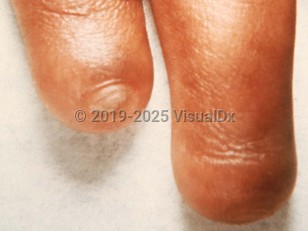Congenital anonychia - Nail and Distal Digit
Alerts and Notices
Important News & Links
Synopsis

Congenital absence of nail involving several digits is rare. Isolated anonychia can be inherited as a dominant, recessive, or sporadic abnormality. Underlying bone abnormalities are often present. Other associated findings include broad, small hands due to skeletal anomalies such as loss of phalanges or isolated fingers and toes (ectrodactyly), syndactyly, or polydactyly.
Patients with nail-patella syndrome, ectodermal dysplasia, anonychia–lymphedema, DOORS syndrome, and Iso-Kikuchi syndrome have anonychia and severe skeletal defects. Dyskeratosis congenita is characterized by bone marrow failure, reticulate pigmentation, nail dystrophy, and oral leukoplakia. Anonychia can be seen in children. Absence of nail may be confined to thumbs and great toes or on the fifth finger in Coffin-Siris syndrome. Use of alcohol, morphine, and antiepileptics in pregnancy has been associated with hyponychia and anonychia.
Anonychia has been linked to chromosome 20p13. Homozygous or compound heterozygous mutations in the gene encoding R-spondin 4 (RSPO4), a secreted protein implicated in Wnt signaling, have been identified, suggesting that RSPO4 has a crucial role in nail morphogenesis.
Patients with nail-patella syndrome, ectodermal dysplasia, anonychia–lymphedema, DOORS syndrome, and Iso-Kikuchi syndrome have anonychia and severe skeletal defects. Dyskeratosis congenita is characterized by bone marrow failure, reticulate pigmentation, nail dystrophy, and oral leukoplakia. Anonychia can be seen in children. Absence of nail may be confined to thumbs and great toes or on the fifth finger in Coffin-Siris syndrome. Use of alcohol, morphine, and antiepileptics in pregnancy has been associated with hyponychia and anonychia.
Anonychia has been linked to chromosome 20p13. Homozygous or compound heterozygous mutations in the gene encoding R-spondin 4 (RSPO4), a secreted protein implicated in Wnt signaling, have been identified, suggesting that RSPO4 has a crucial role in nail morphogenesis.
Codes
ICD10CM:
Q84.3 – Anonychia
SNOMEDCT:
23610003 – Anonychia
Q84.3 – Anonychia
SNOMEDCT:
23610003 – Anonychia
Look For
Subscription Required
Diagnostic Pearls
Subscription Required
Differential Diagnosis & Pitfalls

To perform a comparison, select diagnoses from the classic differential
Subscription Required
Best Tests
Subscription Required
Management Pearls
Subscription Required
Therapy
Subscription Required
References
Subscription Required
Last Reviewed:09/16/2019
Last Updated:08/06/2023
Last Updated:08/06/2023
Congenital anonychia - Nail and Distal Digit

